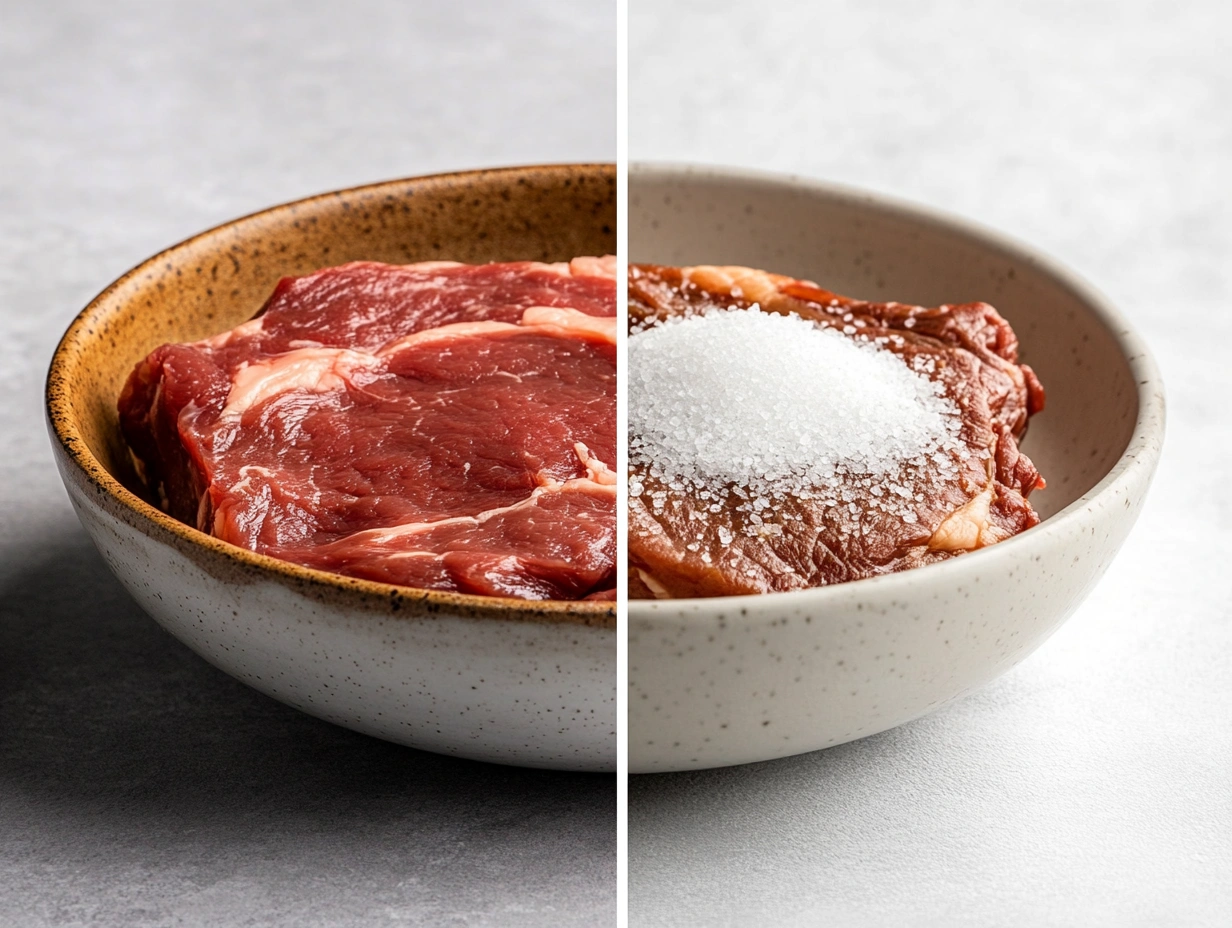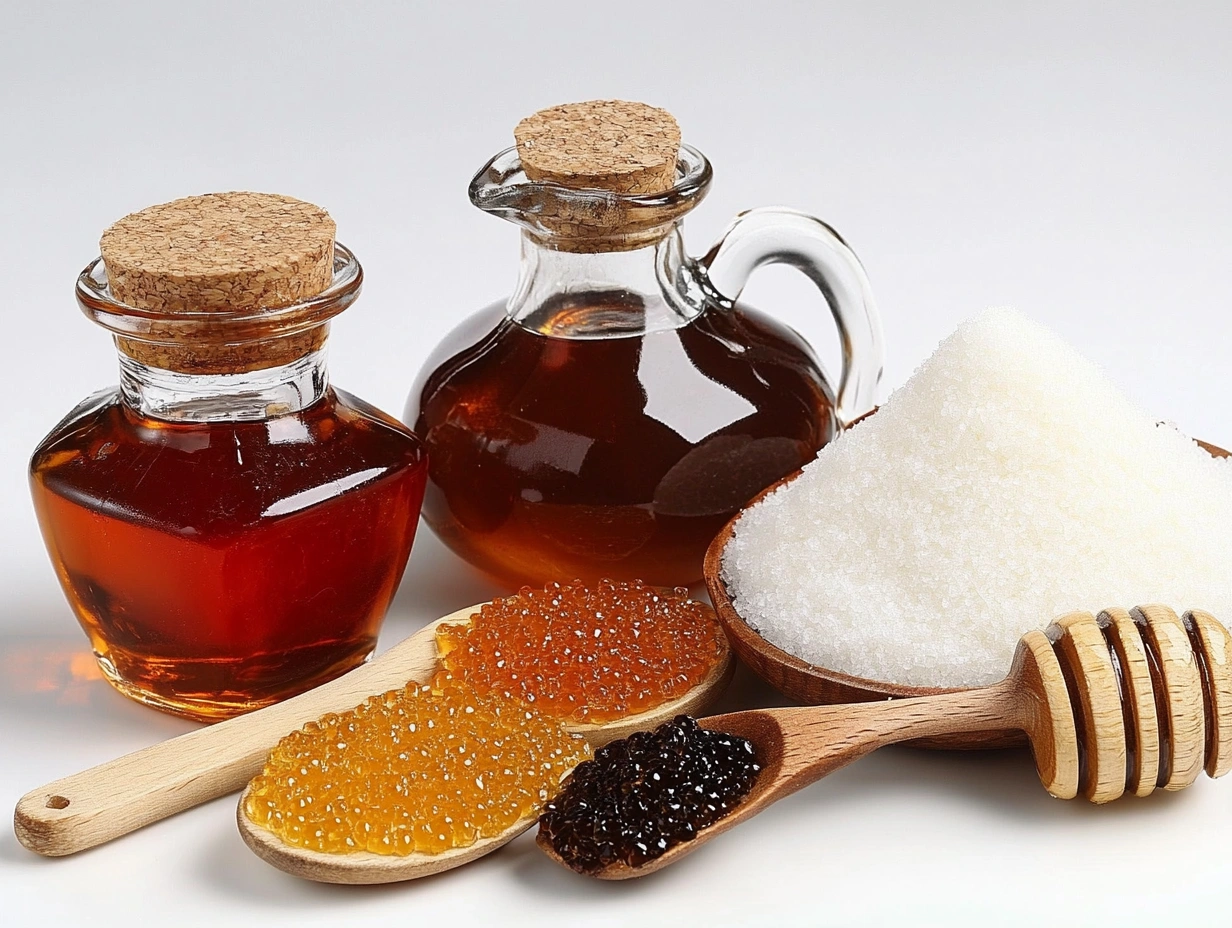Part 1: Introduction and Science of Brining
1. Introduction to Brining and the Role of Sugar
Brining is a popular technique used for meats like chicken, pork, and turkey to retain moisture and improve flavor. The process involves soaking meat in a solution of salt and water, with optional ingredients like sugar, herbs, and spices added for extra flavor.
When it comes to brining, salt is the key ingredient. It draws moisture into the meat, helping it retain juice during cooking. However, many recipes suggest adding sugar to the brin.e. The sugar plays an important role in balancing out the saltiness, and it also contributes to the overall flavor profile. Learn more about how sugar enhances brine.
2. The Science Behind Brining
The magic of brining lies in a process called osmosis. Salt in the brine helps the meat absorb water, ensuring that it stays juicy even after high-heat cooking methods like grilling or roasting. In addition to water retention, salt also breaks down the proteins in the meat, which tenderizes it.
When sugar is added to a brin.e, it also has an effect, primarily by adding a touch of sweetness to the flavor and aiding in browning during cooking. This browning, known as the Maillard reaction, gives the meat that appealing golden color and delicious caramelized crust. To dive deeper into the science of brining, check out The Science of Brining.
3. Common Types of Brines: Wet vs. Dry
There are two primary types of brining: wet brining and dry brining. Wet brining involves submerging the meat in a saltwater solution, often with sugar added. Dry brining, on the other hand, means rubbing the meat with salt (and sometimes sugar) and allowing it to rest without liquid.
For a more detailed explanation of the brining process and tips on creating flavorful brines, check out this Ultimate Guide to Chicken Brine.
In both types of brining, sugar can be added to enhance the flavor. However, the effect of sugar in each method may differ. Wet brining tends to balance out the saltiness more effectively, while dry brining allows for more crispy skin, particularly in roasting.
Part 2: Is Sugar Necessary in a Brine?
4. The Debate: Is Sugar Essential for Brining?
There is a long-standing debate among chefs and home cooks about whether sugar is essential in a brine. Some argue that the main purpose of sugar is simply to balance the saltiness of the brine, while others believe it adds a crucial layer of flavor. In certain dishes, like BBQ or grilled pork chops, sugar is often recommended to enhance the overall taste.
According to culinary experts, sugar is not necessary for the brining process to work, but it can add valuable flavor and texture. It’s especially useful when you want to balance strong flavors or create a caramelized exterior on grilled or roasted meats. Mashed’s article on sugar in brine sheds light on how sugar enhances the final product.
5. Why Some Brine Recipes Call for Sugar
The inclusion of sugar in brine serves several purposes. First, it offsets the saltiness of the brine, giving the meat a more balanced flavor. Secondly, sugar helps improve browning during cooking. As the sugar heats up, it caramelizes, resulting in a beautifully browned crust, especially in dishes like BBQ chicken or roast pork.
Many popular recipes include sugar to improve both the taste and appearance of the meat. Pork and poultry, in particular, benefit from the sweet, golden brown crust that sugar helps create. It’s also common in recipes that involve smoking or grilling, where the caramelization adds depth to the flavor.
6. Can You Skip the Sugar in Brine?
It’s possible to leave out the sugar in a brine, and many sugar-free alternatives can still create tender and juicy meat. For those on low-sugar or low-carb diets, skipping the sugar is a viable option. Instead, you can focus on adding herbs and spices to your brine for additional flavor.
If you choose to skip sugar, the primary change will be in the flavor and browning during cooking. Meat brined without sugar will not caramelize as well, but it will still be moist and flavorful. BBQ Brethren Forum on sugar-free brine provides insight into sugar-free brining and how to maintain flavor without sweetness.
Part 3: Benefits and Drawbacks of Sugar in Brine
7. Benefits of Adding Sugar to Brine
Adding sugar to a brine enhances the flavor by balancing the salt and adding a subtle sweetness. For meats like pork and poultry, this balance can elevate the overall taste. Additionally, sugar aids in the browning process, creating a delicious caramelized crust during grilling or roasting.
Sugar also helps retain moisture in certain meats. While salt is the main ingredient responsible for moisture retention, sugar can enhance the texture, especially in long-cooked or slow-roasted meats like turkey or pork shoulder.
After using sugar in your brine, you can make dishes like this Easy Bibibop Copycat Chicken Recipe for a flavorful meal.
8. Drawbacks of Sugar in Brine
While sugar has its benefits, there are times when it may not be ideal. For example, if you’re on a specific diet that restricts sugar, it’s better to opt for a sugar-free brine. Additionally, sugar can sometimes cause the skin of meats to become overly sticky or too sweet, which might not be desirable for certain recipes.
Another downside to sugar in high-heat cooking is the risk of burning. If the sugar in the brine caramelizes too quickly, it can leave the meat with a slightly bitter or charred taste. It’s important to monitor your cooking temperatures closely when using a brine that contains sugar.
9. Substitutes for Sugar in Brine
If you want to avoid refined sugar in your brine, there are plenty of alternatives. Sweeteners like honey, molasses, agave syrup, and maple syrup can be used to achieve similar results. Each of these substitutes brings its own unique flavor profile, so it’s essential to choose the right one based on the type of meat and cooking method.
For example, honey adds a subtle floral sweetness, while molasses brings a rich, deep flavor. When substituting these sweeteners for sugar in a brine, be mindful of their potency, as they can sometimes overpower other flavors. These natural alternatives also aid in browning and caramelization, much like sugar.
Part 4: How to Brine with and Without Sugar
10. Creating the Perfect Brine with Sugar
To make a brine with sugar, start by dissolving 1 cup of kosher salt and ½ cup of sugar in 1 gallon of water. You can add other ingredients like herbs, spices, and citrus to enhance the flavor. The key is to find the right balance between the salt and sugar, so the final taste isn’t too sweet or too salty.
This type of brine works well for chicken, pork, and turkey. For optimal results, allow the meat to soak in the brine for several hours, depending on the size and cut of the meat. A general guideline is to brine smaller cuts for 1-2 hours and larger cuts for up to 24 hours.
Looking for a great chicken recipe to try with your new brine? This Simple Brine Formula for Chicken offers easy-to-follow instructions.
11. Making a Sugar-Free Brine
A sugar-free brine can be just as flavorful. Begin by dissolving 1 cup of kosher salt in 1 gallon of water. Instead of sugar, rely on herbs and spices to provide flavor. For example, adding garlic, rosemary, bay leaves, and peppercorns can give the brine a rich, savory taste.
This option is perfect for those who are avoiding sugar for health reasons or prefer a less sweet brine. Sugar-free brines work particularly well for fried chicken or grilled meats, where crispiness is the focus.
12. When to Use Sugar in Brine and When to Skip It
Sugar is most beneficial in recipes that involve grilling, BBQ, or roasting, where a caramelized crust enhances the flavor. However, for recipes like fried chicken or for those on low-sugar diets, it’s best to skip the sugar and focus on savory flavors instead.
Adjust your brine recipe based on the final cooking method and your personal preferences. Sugar is a great addition, but it isn’t necessary for every brin.e.
Part 5: FAQs and Conclusion
13. FAQs About Sugar in Brine
- Is sugar necessary in brine?
No, but it improves the flavor and browning in many cases. - What does sugar do in a brine?
It balances salt, adds flavor, and aids in browning during cooking. - Can you brine without sugar?
Yes, you can make effective brines without sugar. You may need to adjust flavorings for balance. - What are the best substitutes for sugar in brine?
Honey, molasses, maple syrup, and agave are great alternatives. - Does sugar penetrate meat during brining?
Sugar mostly affects the surface but also adds a subtle sweetness throughout the meat.
14. Conclusion
Sugar is not a required ingredient for brining, but it has significant benefits. It enhances the flavor, improves browning, and contributes to moisture retention in meats like pork and poultry. Whether you choose to use sugar depends on the final dish and your personal preferences. Experiment with sugar and sugar-free brines to find what works best for your favorite recipes.

